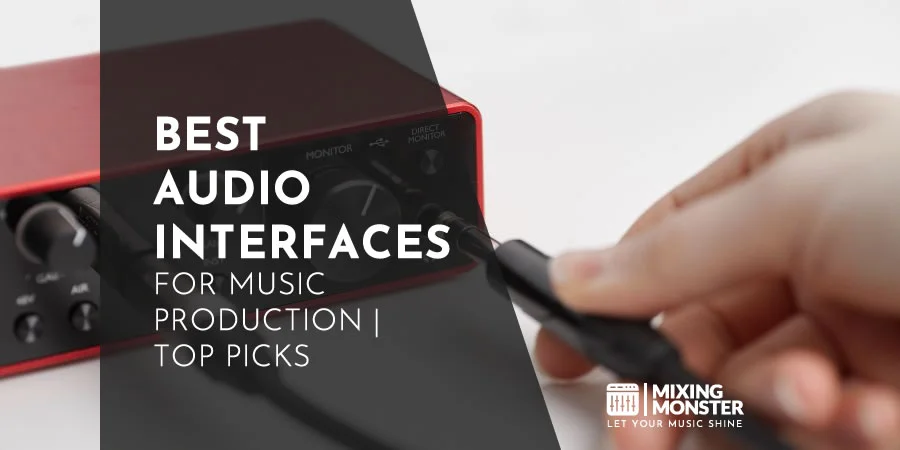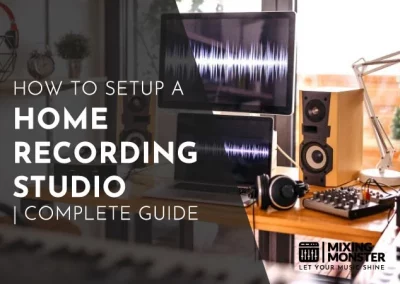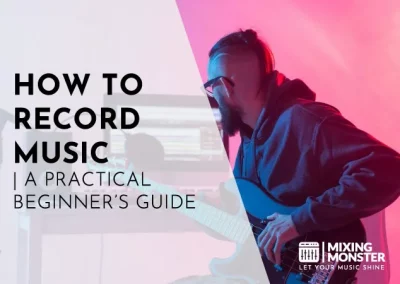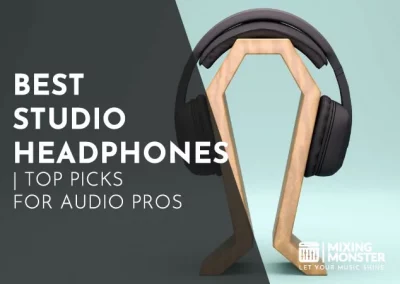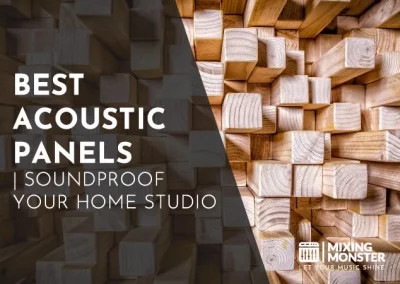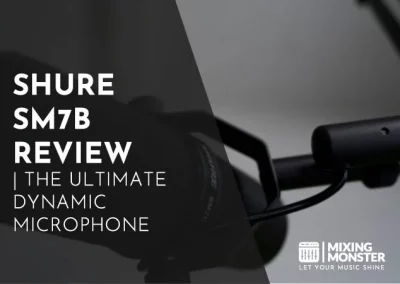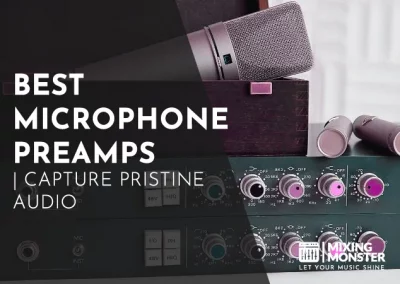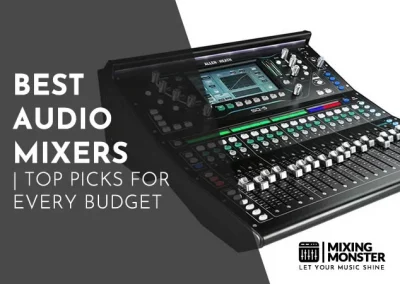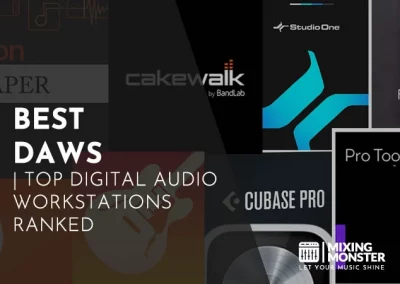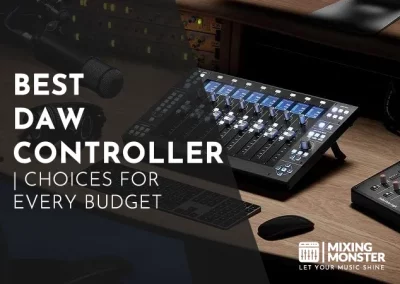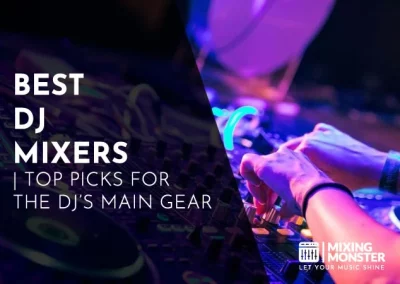Home > Blog > Studio Gear > Home Studio Gear
Disclosure: Some of the links below are affiliate links, meaning that at no additional cost to you, we will receive a commission if you click through and make a purchase. Read our full affiliate disclosure here.
When recording music, podcasts, or digital audio, the gatekeeper to quality is often the audio interface. This equipment lets you capture sound and convert it into a format your computer can use. It acts as the bridge between your microphones, instruments, and the digital realm. Consider it the centerpiece of any home studio setup or mobile recording rig, translating your acoustic nuances into electronic signals with clarity and precision.
An audio interface is a device that connects microphones, instruments, and other audio hardware to a computer, converting analog signals to digital audio. It ensures high fidelity by providing preamps for microphones, high-quality digital converters, and sometimes built-in effects. By facilitating multi-track recording, interfaces allow for the simultaneous recording of several sound sources, making them indispensable in modern audio production.
When shopping for the best audio interfaces, it’s crucial to focus on factors including the quality of the preamps, the number and variety of inputs and outputs, the type of computer connection, and the compatibility with your existing equipment and software. Some interfaces are designed with simplicity for plug-and-play use, while others offer extensive controls for fine-tuning the audio signals. It’s essential to consider the specific needs of your setup, whether you’re a solo musician recording at home, a podcaster in need of multiple microphone inputs, or a producer in a professional studio environment.
We have invested time researching and examining various models to ensure you find an audio interface that fits your home studio or professional use requirements. In our thorough review, we’ll guide you through the top choices, helping you understand the nuances of each and how they can cater to your sound projects. Prioritizing functionality, ease of use, and reliable performance, our selections will help streamline your workflow and enhance the quality of your recordings.
KEYNOTES:
- In this article, you’ll find a comprehensive list of the best audio interfaces on the market.
- Audio interfaces are categorized into 3 sections:
Best Budget Audio Interfaces
Best Midrange Audio Interfaces
Best High-End Audio Interfaces - Each section contains:
5 Audio Interfaces
ordered by price (low > high)
Our Top Picks – Best Audio Interfaces
Table Of Contents
1. What Are The Best Audio Interfaces?
Best Budget Audio Interfaces
Best Midrange Audio Interfaces
Best High-End Audio Interfaces
2. What Is An Audio Interface?
3. Audio Interface Buying Guide
4. Finding Your Perfect Audio Interface: Key Takeaways
5. FAQ

1. What Are The Best Audio Interfaces?
We understand the importance of finding the perfect audio interface to match your recording needs, whether you’re a professional producer or a home studio enthusiast.
After extensive evaluation, we’ve curated a selection of the finest audio interfaces that offer exceptional sound quality, robust build, versatility, and ease of use.
Each product on our list has been chosen for its ability to deliver seamless audio recording and playback, ensuring that your creative process is supported by the best affordable tools available.
Here Are Our Picks For The Best Audio Interfaces:
Best Budget Audio Interfaces
4. Universal Audio Volt 2
Best For Streamlined Home Recording And Podcasting
Best Midrange Audio Interfaces
6. IK Multimedia AXE I/O Solo
Best For Recording Guitarists And Bassists
8. Solid State Logic SSL 2+
Best Entry-Level SSL-Quality Audio Interface
10. Universal Audio Volt 476P
Best For Recording Artists And Podcasters
Best High-End Audio Interfaces
11. Focusrite Clarett+ 4Pre
Best For Advanced Home Studios
12. Black Lion Audio Revolution 6×6
Best For Studio Enthusiasts And Professional Musicians
15. Universal Audio Twin X DUO USB HE
Best For Professional Home Studios
Best Budget Audio Interfaces
#1 Mackie Onyx Artist 1.2
Best For Solo Artists And Content Creators
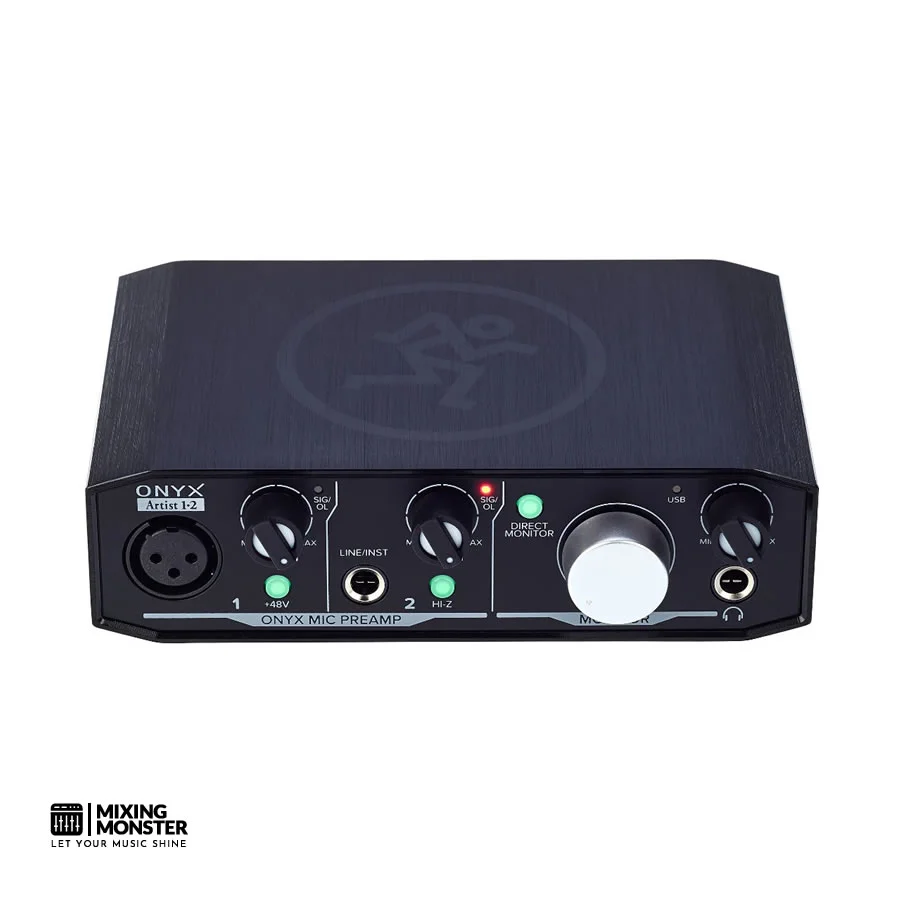
Overview:
The Mackie Onyx Artist 1.2 is a compact, no-frills audio interface that caters to solo performers and digital content creators.
Pros:
- High-quality Onyx mic preamp ensures pristine audio capture
- Easy to use, with straightforward controls suitable for beginners
- Compact and rugged design, ideal for desktop setups or mobile use
Cons:
- Only one microphone preamp, which might limit those needing to record multiple sources simultaneously
- Lacks MIDI connectivity, which could be a drawback for electronic music producers
- Some users may require more input/output options for complex recording setups
Unique Selling Point:
Thanks to the renowned Onyx mic preamp, the Mackie Onyx Artist 1.2 is known for its exceptional sound quality. This interface is designed to deliver studio-grade recordings in a user-friendly package, making it an excellent choice for solo artists and podcasters.
Key Benefits:
- Delivers professional audio quality with a renowned Onyx microphone preamp, enhancing your recordings with clarity and warmth.
- The compact size makes it an excellent option for creators with limited space or those who need a portable recording solution.
- Bus-powered for convenience allows you to record anywhere without needing an external power source.
Pricing:
| Average Price | ~ $90 |
Review:
In our experience, the Mackie Onyx Artist 1.2 stands out for its simplicity and audio fidelity. The setup process is incredibly straightforward, so you can start recording almost immediately after unboxing. Its robust build quality assures us that this little unit can withstand the rigors of travel, making it a reliable companion for performers on the move.
The Onyx preamp impressed us with its clear and detailed sound reproduction. Whether we recorded vocals or acoustic instruments, the results were consistently professional. The lack of multiple inputs and MIDI I/O is noticeable, but for a solo artist or podcaster, the single high-quality input is more than sufficient.
The absence of additional I/O does mean that this interface might not suit those with more extensive recording needs. However, the Onyx Artist 1.2 delivers excellent sound in a simple package for its intended audience. The interface’s bus-powered design adds to its appeal, removing the need for an external power source and ensuring a tidy setup with minimal cabling.
Although the Onyx Artist 1.2 might not have the bells and whistles of more elaborate setups, its focus on core functionality and sound quality must be balanced. It’s ideal for singer-songwriters, mobile producers, and podcasters who prioritize audio quality and portability over complex configurations.
In conclusion, the Mackie Onyx Artist 1.2 is a solid choice for individuals seeking a straightforward, high-quality audio interface. Its affordability, combined with the renowned Onyx preamp, presents a valuable package for those starting their recording journey or needing a reliable, portable solution.
While it may not cater to every recording scenario, its performance in its niche is exceptional. If you’re a solo artist or content creator looking for an interface that balances cost, quality, and ease of use, the Onyx Artist 1.2 could be the perfect addition to your creative toolkit.
#2 Presonus AudioBox USB 96
Best For Home Studios And Mobile Recording
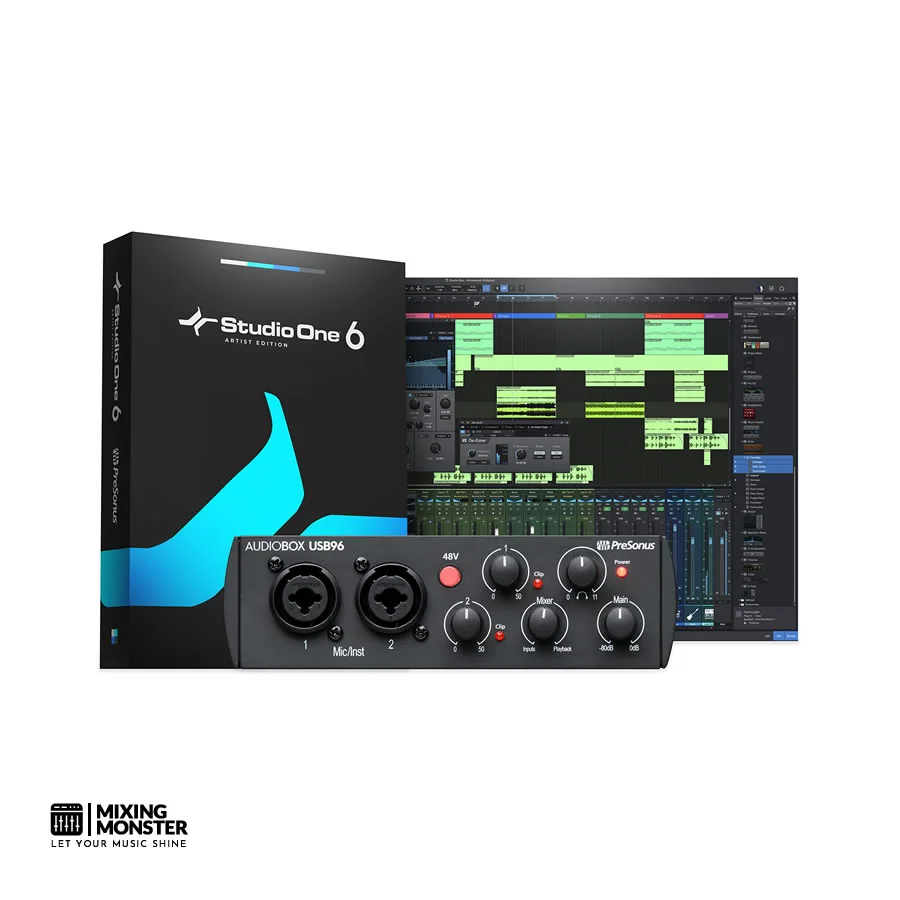
Overview:
If you’re stepping into audio production, the PreSonus AudioBox 96 should be noticed.
Pros:
- Simplifies the recording process with its easy setup
- It is portable, making it perfect for recording on the go
- Offerings of free software add tremendous value
Cons:
- Limited to USB 2.0 connectivity, which may not be ideal for all users
- Some users have reported challenges with software downloads
- A few reviewers mentioned occasional unwanted noise during the recording
Unique Selling Point:
The PreSonus AudioBox 96 sets itself apart with the ability to transform a simple laptop into a mobile recording studio. Its combination of durable construction and invaluable software suite makes it a standout choice for newcomers and experienced users alike.
Key Benefits:
- Allows for high-quality recordings with its studio-grade converters, elevating your audio projects.
- It comes with an impressive array of recording software, which can be a significant cost-saving for musicians and podcasters.
- The straightforward mixer control makes monitoring recordings hassle-free and intuitive.
Pricing:
| Average Price | ~ $99 |
Review:
Our recent hands-on experience with the PreSonus AudioBox 96 was positive. Setting it up was a breeze; we appreciated not needing to grapple with complex installations. The bus-powered feature ensured we could easily pack the unit and record wherever inspiration struck – convenient for outdoor sessions or impromptu gigs.
We especially enjoyed the sound clarity provided by the high-quality preamps. The onboard phantom power made recording with our favorite condenser microphones a delight. And though it’s common in this price range, including world-class software made this interface a serious value proposition.
However, it had its flaws. While the unit performed admirably, the USB 2.0 connection presented some limitations in data transfer speeds, which may matter to tech-savvy users. We also learned from other users’ feedback that downloading and installing the included software might require some patience and support assistance.
In our assessment, the AudioBox 96 shines for its robustness and ease of use. We found ourselves recording quickly, and with very little fuss, we were laying down tracks that sounded crisp and professional. The mixer control was remarkably user-friendly, balancing the input and playback for zero-latency monitoring – an essential feature for realtime recording tweaks.
Wrapping up, the AudioBox 96 by PreSonus holds its ground as a solid entry-level interface. Given its affordable price tag, portability, and comprehensive software bundle, its value is hard to beat for anyone looking to kickstart their recording journey. If you can overlook its minor limitations, this interface could be the compact powerhouse to capture your creativity wherever you are.
#3 Audient iD4 MKII
Best For On-The-Go Recording Enthusiasts
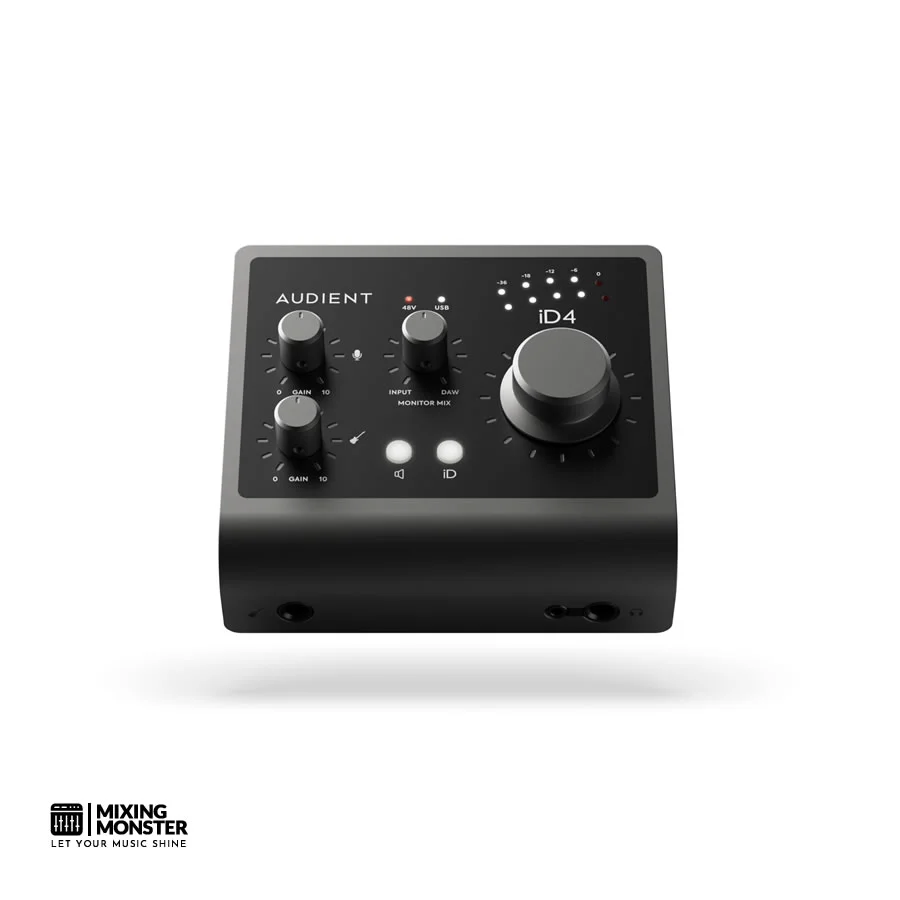
Overview:
The Audient iD4 MKII is a smart buy for those requiring top-notch sound quality in a portable package.
Pros:
- Outstanding audio quality
- Robust, travel-friendly design
- Ease of use with USB-C connectivity
Cons:
- Limited I/O might not suit extensive session recording
- No MIDI connectivity
- Software bundles may be limiting for some users
Unique Selling Point:
The iD4 MKII‘s unique selling point is its Class-A microphone preamplifier, derived from Audient’s top-tier ASP8024 HE console. This provides an unprecedented audio quality in its class, shaping our recordings with professional clarity and warmth.
Key Benefits:
- With a Class-A console microphone preamp, our recordings carry a distinct professional signature sound.
- The all-metal construction means the iD4 MKII withstands our on-the-move lifestyle without a hitch.
- USB-C functionality ensures quick data transfer rates and compatibility with contemporary devices without hassles.
Pricing:
| Average Price | ~ $189 |
Review:
In our hands-on experience, the Audient iD4 MKII impresses with reliable performance, especially when capturing vocal and instrument nuances. Its solid build gives us confidence during transport, and the setup is straightforward — plug it into the computer, and we’re ready to roll. The USB-C connection also ensures seamless integration with modern production setups.
Initially, upon unboxing the Audient iD4 MKII, we were taken aback by its sturdy, sleek design. Our tests show that it’s not just about looks; this interface captures every subtlety of our vocal and guitar performances with impressive precision.
We appreciate the simplicity of the monitor mix feature, letting us dial between our computer audio and direct input for zero-latency monitoring. However, we sometimes wish for more inputs to accommodate additional recording equipment during larger sessions.
Despite this, we must recognize the interface’s robust sound quality. The preamps are a cut above — clean, detailed, and accurate to the source. It’s a constant in our audio toolkit, connecting effortlessly to our gear at home or on the road.
The Audient iD4 MKII reaffirms why the brand is respected amongst audio professionals. After spending significant time with it, we’re convinced it’s a valuable asset to any setup, big or small. Whether you’re just starting or looking to upgrade, the iD4 MKII merits serious consideration.
#4 Universal Audio Volt 2
Best For Streamlined Home Recording And Podcasting
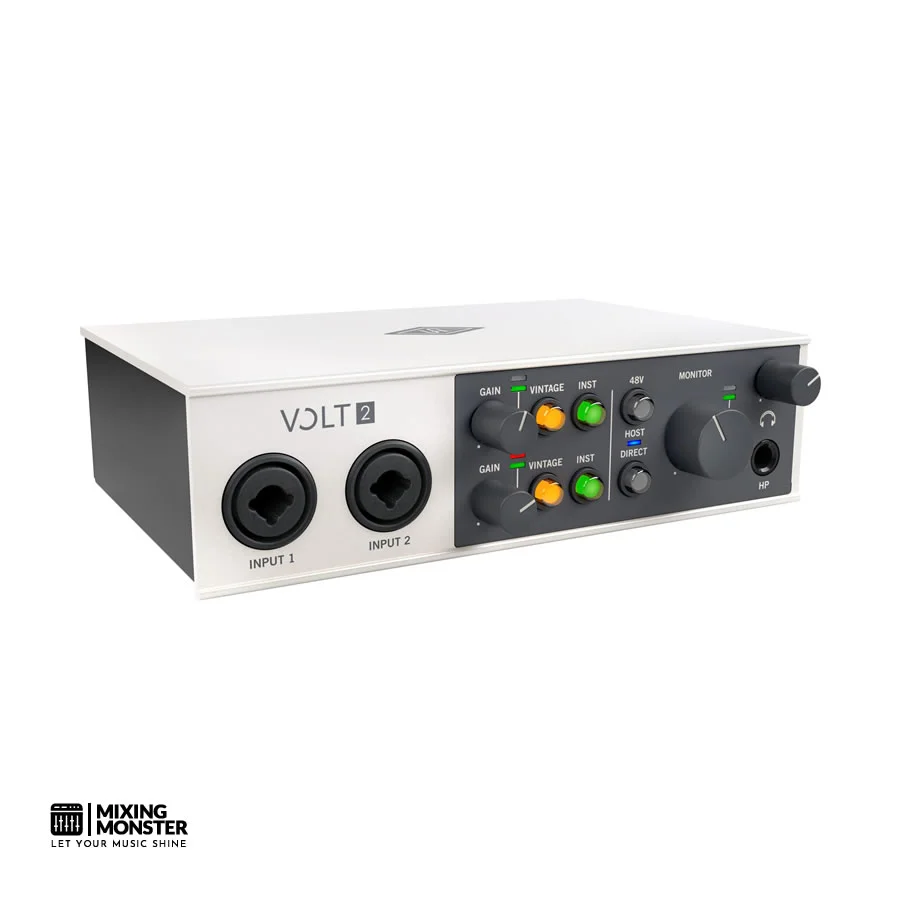
Overview:
We believe that the UA Volt 2 is an ideal pick for those seeking studio-quality recordings without the studio.
Pros:
- Intuitive one-button operation for ease of use
- It comes with a suite of high-quality plugins
- Vintage Mic Preamp mode adds warmth to recordings
Cons:
- Limited input/output may not suit more complex setups
- Some users report minor software bugs
- Lacks the advanced routing options found in higher-end models
Unique Selling Point:
The UA Volt 2 shines with its Vintage Mic Preamp mode, a standout feature derived from the legendary UA 610 tube preamp. It’s as if we’re channeling a piece of recording history right from our desktop.
Key Benefits:
- Professional Sound:
The Volt 2 doesn’t skimp on audio quality, ensuring our recordings are crisp and clear. - Portability:
This audio interface is bus-powered, compact, and easily connects to computers and iOS devices, making it perfect for recording on the go. - Rich Software Bundle:
The included industry-leading software like Ableton and Melodyne enhances our music production without requiring immediate investments.
Pricing:
| Average Price | ~ $189 |
Review:
Our experience with the UA Volt 2 has been overwhelmingly positive, from unboxing to actual recording sessions. The build quality is robust, giving us confidence in its durability for home and mobile use. As soon as we plugged it in, we appreciated the straightforward setup.
We didn’t have to fumble through complicated settings; a simple button press and we were recording with that vintage warmth that’s quite hard to come by at this price point.
One of the Volt 2’s greatest assets is the included software. It’s not just filler; these are genuinely useful tools that enhance our production workflow. From creating beats to finessing vocals, the plugins bring much to the table. And was it recording on the iPad? A breeze. It stirs up creativity, being able to lay down ideas wherever we are with such ease.
We did notice it needs more flexibility; our more advanced projects sometimes require only two inputs and two outputs. Some users have mentioned occasional software hiccups, though we encountered nothing that hindered our overall experience.
The UA Volt 2 is a worthy companion for our recording endeavors. Its focus on quality and ease of use makes it a solid choice for anyone looking to capture sound with clarity and character. After hands-on sessions with this interface, we confidently recommend it to fellow creators.
#5 Focusrite Scarlett 2i2 4th Gen
Best For Home Studio Music Production Beginners
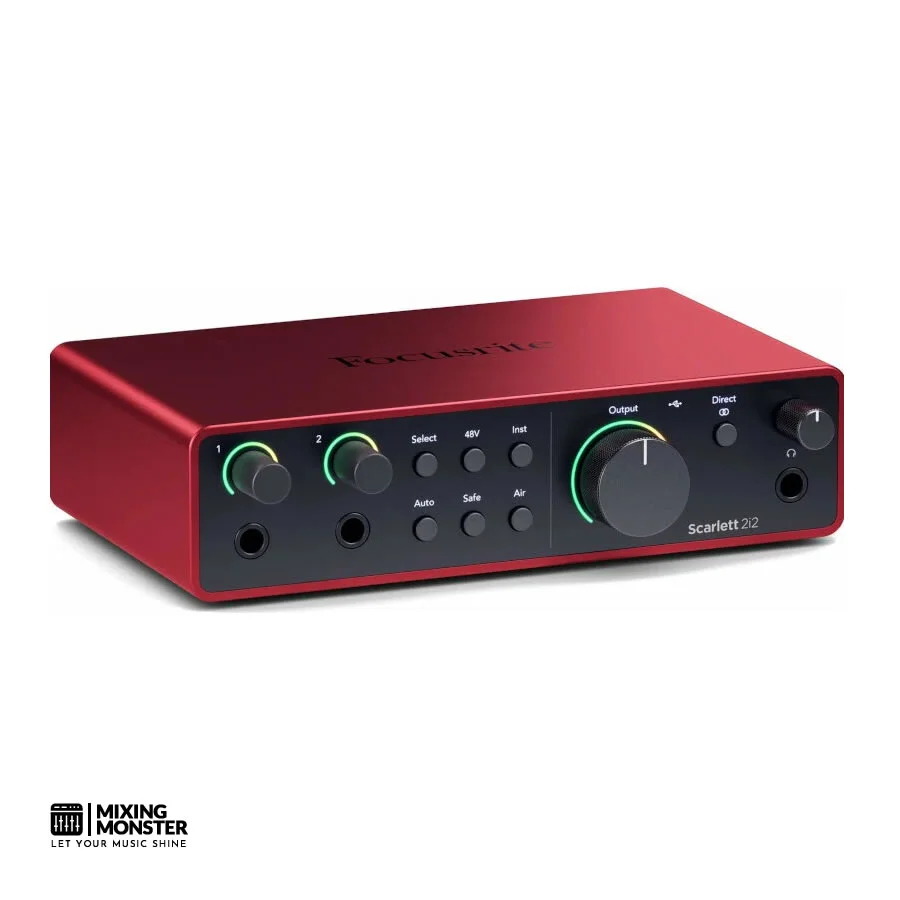
Overview:
Consider the Focusrite Scarlett 2i2 if you’re looking for a reliable and high-quality audio interface that’s easy to use and packed with features for home recording.
Pros:
- Pristine preamps and significant dynamic range for crystal clear recording
- Intuitive Auto Gain and Clip Safe features to protect your takes
- Bundled with an extensive range of professional-grade software and plugins
Cons:
- Only two inputs, which may limit those who need to record multiple sources simultaneously
- USB 2.0 connectivity might not be the fastest for some users
- The Air mode’s distinct sound may not suit all recording needs
Unique Selling Point:
The minimal noise and the vast dynamic range of the Focusrite Scarlett 2i2 4th Gen are what set it apart. It feels like bringing a piece of a pro studio into your home that can unlock your potential, no matter what gear or instruments you’re using.
Key Benefits:
- With its high-headroom preamps, you can capture the detail in your performances without fearing distortion.
- Its compact design makes it the perfect travel companion, enabling high-quality recordings.
- The software package provides all the tools you need for production, from recording to mastering, making it a complete solution for artists.
Pricing:
| Average Price | ~ $250 |
Review:
We’ve recently spent time with the Focusrite Scarlett 2i2 and can vouch for its performance. The setup was a breeze, and we were ready to record within minutes. Its preamps are impressively clean—giving vocals and guitars a polished sound without fuss.
The inclusive software bundle has been a boon, allowing us to experiment with different production styles immediately. Although it’s mainly suited for solo musicians or small setups due to its two-input configuration, it offers undisputed value for those who do not require more.
Spending days with it in various recording scenarios has shown us its versatility, whether it’s a simple podcast session or laying down tracks for a new song. We concluded our session with a new level of appreciation for its straightforwardness.
The Focusrite Scarlett 2i2 left us feeling like it had significantly outperformed our expectations, proving its worth as a foundational tool for recording.
Best Midrange Audio Interfaces
#6 IK Multimedia AXE I/O Solo
Best For Recording Guitarists And Bassists
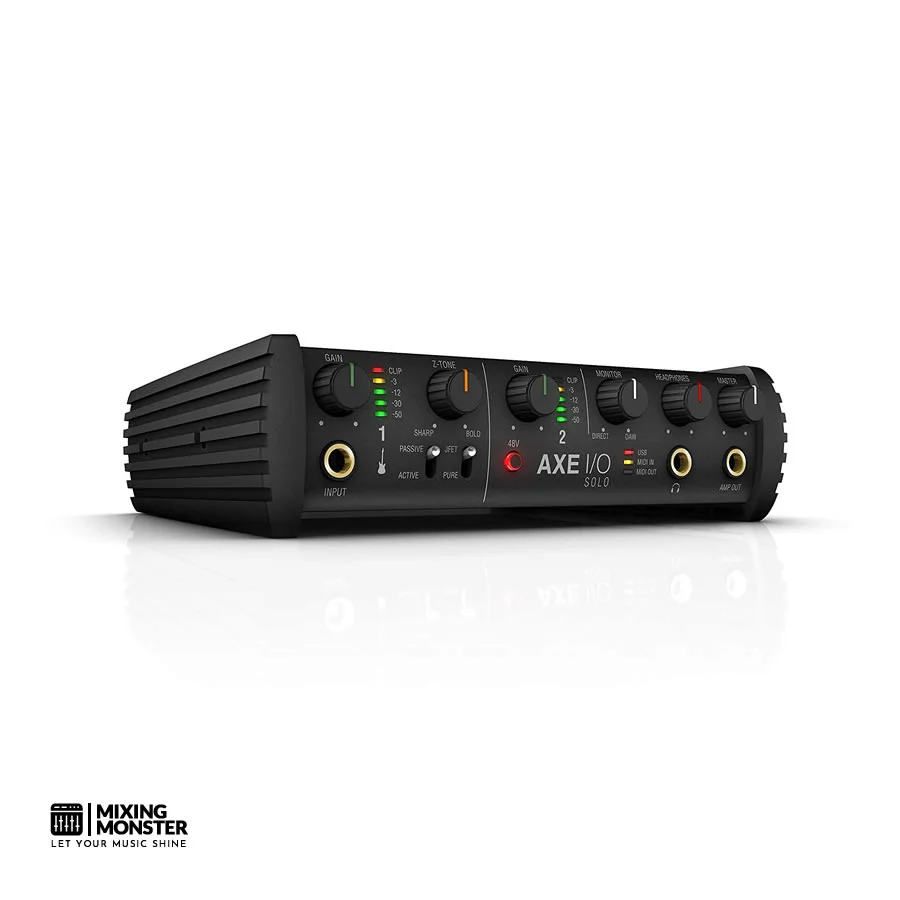
Overview:
If you’re looking for rich guitar tones and studio-grade recordings at home, the AXE I/O SOLO might be your pick.
Pros:
- Impeccable high-resolution audio captures the nuances of your performance.
- Innovative guitar tone shaping with Z-Tone offers flexibility for any style.
- It comes with a massive software bundle that opens up endless creative opportunities.
Cons:
- Lacks the robust build of some higher-end interfaces.
- The included software may have a learning curve for beginners.
- Limited I/O could be restrictive for users with multiple instruments.
Unique Selling Point:
The AXE I/O SOLO‘s standout feature is its advanced guitar tone shaping. Tailor your input to match the character of your guitar while using the interface—it feels like having a high-end amp at your fingertips.
Key Benefits:
- The device’s high-resolution recording ensures every lick and riff is captured, solidifying our productions with a professional sheen.
- Our guitar sessions are drastically elevated with the Z-Tone impedance circuit, tweaking our sound to perfection before it even hits the DAW.
- Benefiting from the impressive AmpliTube and TONEX software bundle, we dive into endless sonic landscapes, which would otherwise require a fortune in physical gear.
Pricing:
| Average Price | ~ $265 |
Review:
Our recent recording sessions with the IK Multimedia AXE I/O SOLO have shown this interface to be a powerhouse for guitarists. The unit’s conversion clarity ensures our takes are pristine and full-bodied. When laying down tracks, the Z-Tone impedance circuitry allows us to dial in the exact response our guitars need, giving tracks a tailored feel that stands out.
The device’s focus on stringed instruments is independent of its ability to capture other sources with finesse. Whether we hook up a vintage microphone or a keyboard, recordings retain their essence, translating performances faithfully. The sheer variety and quality of the AmpliTube and TONEX plugins are astounding, evoking the sensation of having every classic amp and effect at our disposal.
Despite the rugged performance, the form factor feels less stout than some competitors. However, this does nothing to diminish the top-notch audio quality. Some of us initially grappled with the software—a weekend deep dive had us wielding it like pros.
Overall, the IK Multimedia AXE I/O SOLO is an intelligent investment for serious guitarists and producers looking to bring studio-grade recordings into their creative space. The interface isn’t just about sounding great; it’s about feeling inspired during every session.
By the end of our time with it, doubts are replaced with excitement for the next track. And that’s the hallmark of a solid home studio companion.
#7 MOTU M4
Best Preamps In An Audio Interface At This Price
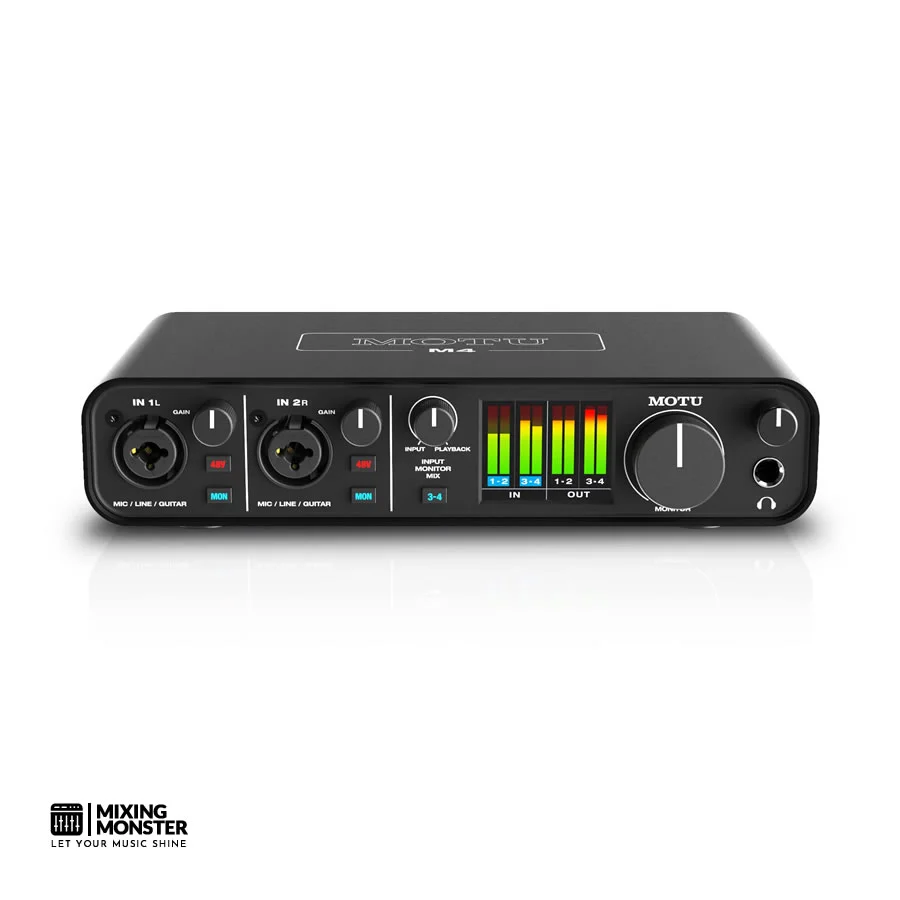
Overview:
If you’re in the market for a professional, reliable and still affordable audio interface, the MOTU M4 should be a top contender on your list.
Pros:
- Exceptional sound quality with ESS Sabre32 Ultra DAC Technology
- Super low latency enabling seamless recording and monitoring
- Full-color LCD for precise level metering
Cons:
- Lack of protective cover for the LCD screen
- Absence of USB-C to USB-C cable for modern connectivity
- Output mirroring is not as straightforward as some competitors
Unique Selling Point:
The MOTU M4‘s unique selling point is its industry-leading dynamic range and advanced metering capabilities. The interface allows us to keep a close eye on our levels, ensuring pristine audio capture.
Key Benefits:
- The ESS Sabre32 Ultra DAC Technology provides superb audio fidelity, enhancing the quality of recordings.
- The interface dramatically reduces roundtrip latency, facilitating realtime monitoring and processing without perceptible delay.
- Including comprehensive metering via an LCD offers a professional experience, allowing for accurate level adjustments while recording or mixing.
Pricing:
| Average Price | ~ $280 |
Review:
Our time with the MOTU M4 formed a lasting impression of what a home studio audio interface can accomplish. Its exceptional DAC technology heralds a clarity in sound that rivals far more expensive gear. Complementing this is the swift performance in handling audio inputs and outputs, ensuring that what we play is what we hear without annoying delay.
The full-color LCD has been valuable, giving realtime feedback usually reserved for higher-end models. We always knew where we stood with our levels, which is critical for avoiding distortion or underpowered recordings. Furthermore, the M4’s ability to loop back audio has simplified our streaming and podcasting workflow, integrating live and computer-based sources effortlessly.
However, a minor gripe was the absence of additional cabling options right out of the box, which could maximize its feature set on day one. We also felt it would benefit from a minor design tweak to add a protective cover over its LCD for added longevity.
Having extensively used the MOTU M4, we affirm it delivers a professional experience in a compact form factor. Its strengths far outweigh its minor weaknesses, making it a worthy investment for creators who demand top-tier performance without breaking the bank. Whether tracking vocalists, electronic instruments, or producing podcasts, the M4 has become a cornerstone of our audio setup.
#8 Solid State Logic SSL 2+
Best Entry-Level SSL-Quality Audio Interface
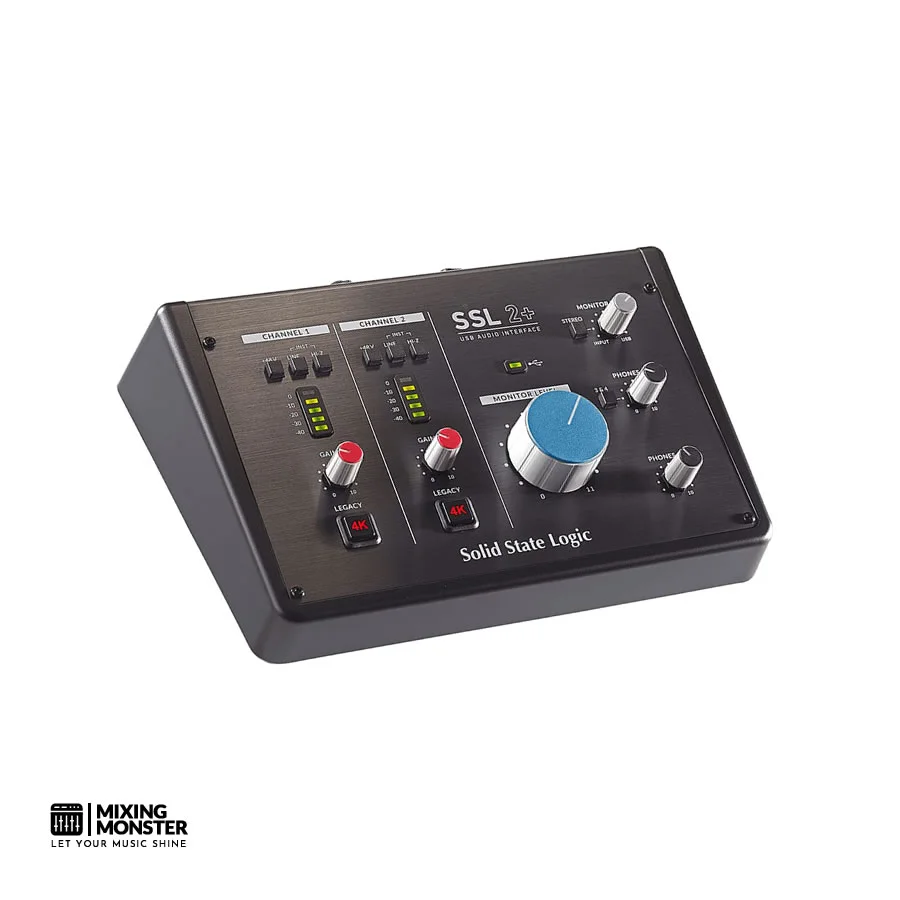
Overview:
The SSL 2+ is stellar for those needing top-tier sound quality in a compact package. Its stellar preamps deliver that esteemed SSL sound clarity.
Pros:
- Exceptional preamps offer pristine audio capture.
- Legacy 4K analog enhancement adds warmth to recordings.
- High-current headphone outputs provide precise monitoring.
Cons:
- Lacks MIDI connectivity.
- Plastic construction may feel less durable.
- Limited I/O could be restrictive for advanced users.
Unique Selling Point:
The hallmark of the SSL 2+ is undoubtedly its SSL-designed microphone preamps, which have brought the industry-standard console sound to a USB interface. Whether we’re recording vocals or instruments, the detail and richness these preamps impart are simply unmatched at this product’s price point.
Key Benefits:
- The preamps ensure that recordings are imbued with unrivaled clarity and depth, making this unit suitable for professional-level projects.
- With the Legacy 4K button, we add a distinct analog character to our sounds, emulating the sonic traits of SSL’s legendary consoles.
- The dual headphone outputs have been a godsend for sessions requiring multiple monitoring mixes, offering flexibility and convenience.
Pricing:
| Average Price | ~ $290 |
Review:
From the moment we unboxed the SSL 2+, the unit’s footprint was perfect for our limited desk space, fitting in effortlessly with the rest of our gear. Recording through this interface, it’s clear why SSL’s reputation precedes them – the audio fidelity was impressive across various microphones and instruments.
We particularly reveled in the Legacy 4K feature, which injected an extra layer of sonic color that’s hard to find outside professional studios. This feature has become a regular part of our toolkit, adding life to our recordings.
While the plastic build initially gave us pause, it’s proven robust through regular use. The interface is straightforward, eschewing unnecessary complexity, which allowed us to focus solely on capturing great takes. The headphone amps deliver ample power, efficiently driving our monitoring headphones and ensuring accurate playback.
Despite its modest size, the SSL 2+ punches well above its weight.
Artists and producers prioritizing audio quality and portability will find this interface a reliable ally. However, those who require more inputs and outputs or seek to incorporate additional hardware via MIDI might hit a wall with this unit.
Regardless, the SSL 2+ has become an essential cog in our recording rig, consistently delivering professional results on the move or in the heart of our studio. We conclude with a nod to the SSL 2+ for its remarkable contribution to our production process.
#9 Focusrite Scarlett 4i4 4th Gen
Best For Home Studio Music Production Beginners

Overview:
The Focusrite Scarlett 4i4 stood out for its pristine clarity and versatility when considering upgrading our home studio setup.
Pros:
- Exceptionally clear preamps
- Versatile input/output options for various recording scenarios
- Bundled software expands creative possibilities
Cons:
- USB-C connection might require adapters for some setups
- Lacks dual headphone outputs for collaborative recording sessions
- Limited onboard controls for immediate physical adjustments
Unique Selling Point:
The Scarlett 4i4‘s unique selling point lies in its stunningly transparent preamps. These preamps allow us to capture the true tone of our instruments or voice without added noise or coloration, which is a game-changer for both amateur and professional projects.
Key Benefits:
- The ‘Air’ mode feature injects recordings with a subtle enhancement reminiscent of classic transformer-based preamps, beneficial for giving tracks a professional sheen.
- Including Pro Tools Artist and Ableton Live Lite, this interface significantly enriches our production capabilities straight out of the box.
- The intuitive Auto Gain and Clip Safe functionalities help us avoid technical mishaps, ensuring we keep our takes clean and usable.
Pricing:
| Average Price | ~ $335 |
Review:
Our experience with the Focusrite Scarlett 4i4 has been incredibly positive. From unboxing to recording our first tracks, the ease of use and audio quality were apparent.
The 4i4 provides ample connectivity for a moderate home studio setup, accommodating microphones, instruments, and MIDI devices without sweat. While we would have appreciated an extra headphone out for dual monitoring, it’s okay, given the unit’s compact size and price point.
The bundled software is a treasure trove that encourages creativity and offers tools that otherwise would be substantial additional investments.
Whether recording podcasts, music, or other multimedia content, the 4i4’s reliability and clear sound have never failed us. If we had to describe our journey with the Scarlett 4i4 in a few words, it would be ‘effortless professionalism.’
Concluding our time with the 4i4, it has more than justified its reputation and standing in the audio interface market.
#10 Universal Audio Volt 476P
Best For Recording Artists And Podcasters
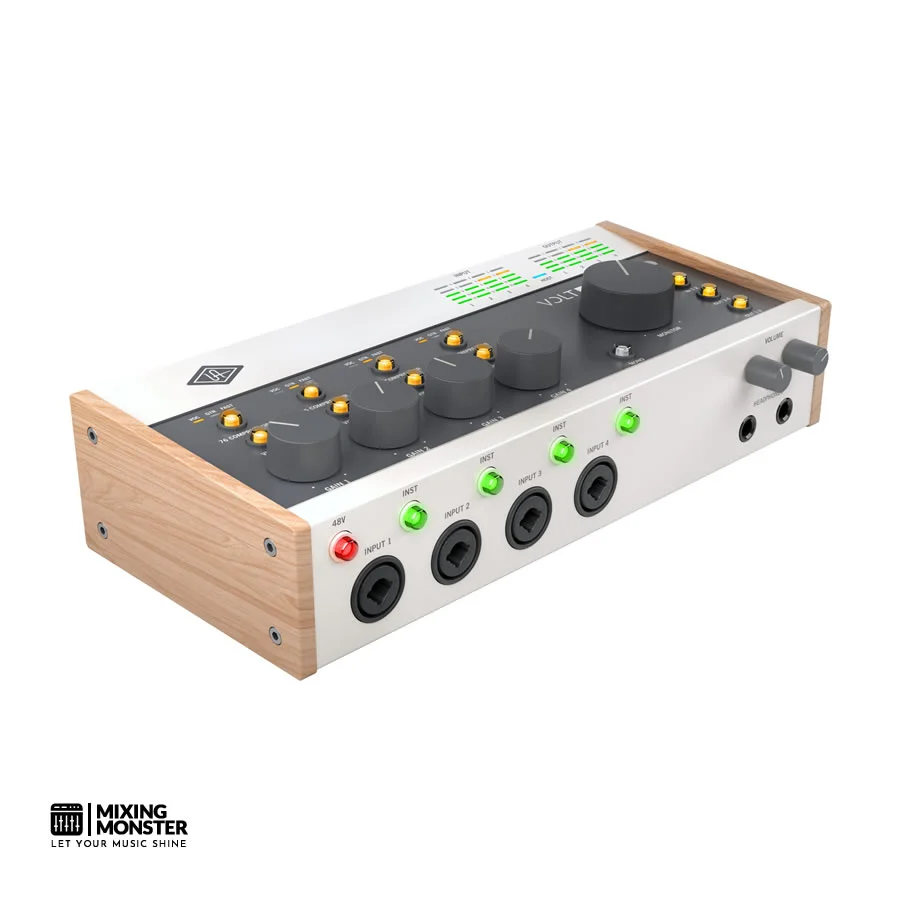
Overview:
After extensive use, the Universal Audio Volt 476P stands out as a top choice for both novices and seasoned pros needing supreme sound quality for recordings or podcasts.
Pros:
- The intuitive one-button recording feature streamlines the setup process.
- Built-in 76 Compressor adds a professional polish to audio tracks.
- Robust build quality ensures durability for both home and mobile use.
Cons:
- USB 2.0 connectivity may limit data transfer speeds compared to newer interfaces.
- The preamp’s “warmth” might be subtle and not meet everyone’s expectations.
- Minor bugs were reported, indicating potential firmware improvements needed.
Unique Selling Point:
The unique selling point of the UA Volt 476P is undoubtedly its Vintage Mic Preamp, which emulates the warmth and character of a classic analog preamp, turning simple recordings into professional-sounding tracks.
Key Benefits:
- The included software suite, valued at $400, equips users with an array of UAD plugins for diverse sound sculpting options.
- Compatibility across Mac, PC, iPad, and iPhone ensures flexible use across devices for producers and podcasters.
- Based on the 1176, its analog compressor offers unparalleled control over dynamics for crisp and articulate audio capture.
Pricing:
| Average Price | ~ $400 |
Review:
Upon setting up the UA Volt 476P on our workstation, the seamless integration with our digital audio workstation stood out. Recording felt effortless, and the one-button Vintage Mic Preamp mode was a game-changer, swiftly breathing life into the raw sound. The built-in 76 Compressor took our production to the next level, lending that much sought-after studio-quality punch and clarity.
During our tests, we noted the interface’s sturdy construction. It’s built to last, which is reassuring for those who frequently carry their gear on the road. Including a generous audio software suite accelerates the creative process, allowing us to tap into exquisite sound-shaping capabilities from the moment we first hit record.
We observed the USB 2.0 connectivity—which may not be the latest technology—kept up admirably with our demands. Although we encountered minor firmware-related bugs, subsequent updates from Universal Audio could quickly resolve these.
After weeks of use in various recording scenarios, the UA Volt 476P consistently impressed us with its reliability and premium audio quality. Whether for a singer-songwriter, podcaster, or multi-instrumentalist, this audio interface provides the tools necessary for professional-grade productions.
As we wrapped up our review session, the interface’s lights dimmed, leaving us feeling pure satisfaction with the equipment. The UA Volt 476P is a compelling choice for serious artists and podcasters seeking to elevate their craft.
Best High-End Audio Interfaces
#11 Focusrite Clarett+ 4Pre
Best For Advanced Home Studios
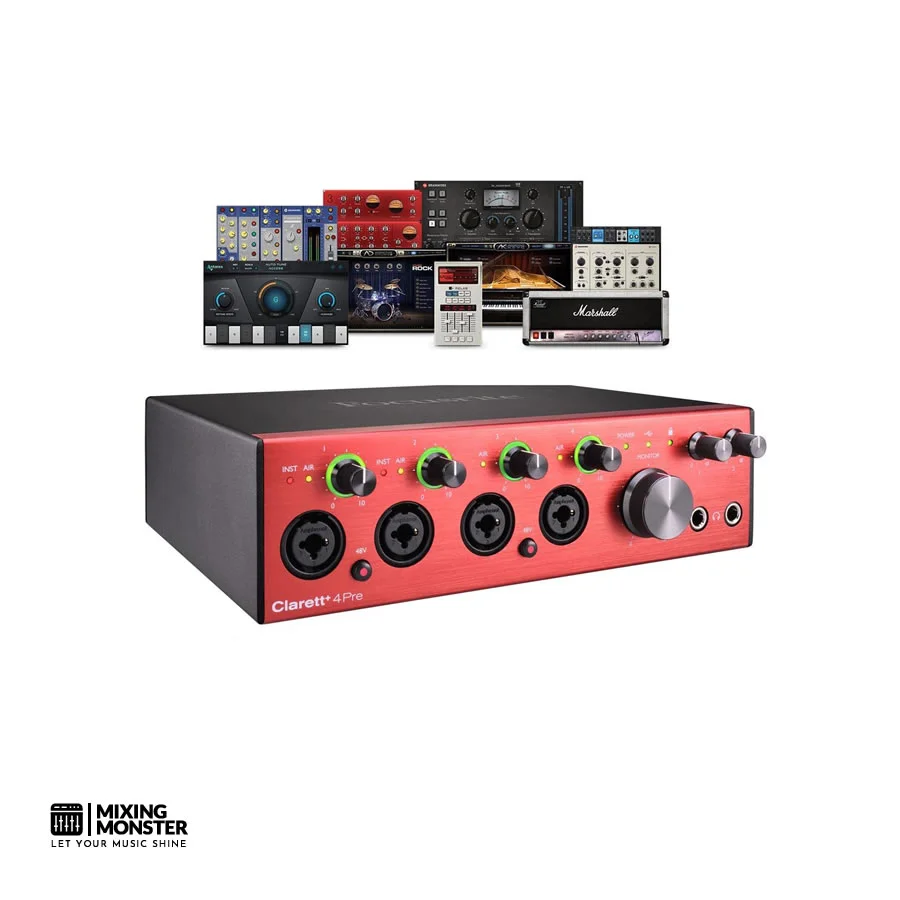
Overview:
If you’re aiming for professional-level recordings, look no further. Building our session with the Focusrite Clarett+ 4Pre was effortless, thanks to the interface’s intuitive front panel and included Focusrite Control software.
Pros:
- Stellar preamps that deliver pristine clarity
- Enhanced headphone outputs for detailed monitoring
- Robust build and intuitive design for seamless use
Cons:
- Premium price point may deter budget-conscious buyers
- Lack of loopback feature, which some alternatives offer
- Some users report software challenges depending on the setup
Unique Selling Point:
The all-analog ‘Air’ feature on the Focusrite Clarett+ 4Pre breathes life into our recordings, emulating Focusrite’s classic ISA preamp’s transformer-based impedance to give vocals and acoustic instruments a lustrous sheen that stands out in the mix.
Key Benefits:
- The improved headphone outputs encourage performers, offering crystal-clear monitoring that ensures impeccable takes.
- Two JFET instrument inputs retain the true character of our guitars and basses as if directly plugged into an amp.
- ADAT expansion capabilities allow for a significant increase in input channels, accommodating larger recording sessions.
Pricing:
| Average Price | ~ $650 |
Review:
The Focusrite Clarett+ 4Pre has proven its worth. The four Clarett mic preamps bring out the best in our recordings, and the extended dynamic range of A-D and D-A converters leaves little to be desired regarding audio fidelity.
We’ve been thoroughly impressed throughout several sessions with the Focusrite Clarett+ 4Pre. The interface integrates with our setup straight out of the box, removing barriers between us and our creative process.
The low noise floor and the transparent sound of the preamps have captured every nuance of our performances. Whether layering multiple vocal tracks or dialing in the perfect guitar tone, the Clarett+ 4Pre has easily handled everything we’ve thrown at it.
Its solid construction also reassures us that it’s a long-term investment for our studio. Toward the tail end of our review period, we encountered the reported software issues, which, while not a dealbreaker, required some troubleshooting.
Despite this hiccup, our experience remains overwhelmingly positive. We conclude our review confident in recommending the Clarett+ 4Pre as a top-tier choice for those seeking to elevate their recording setup.
#12 Black Lion Audio Revolution 6×6
Best For Studio Enthusiasts And Professional Musicians
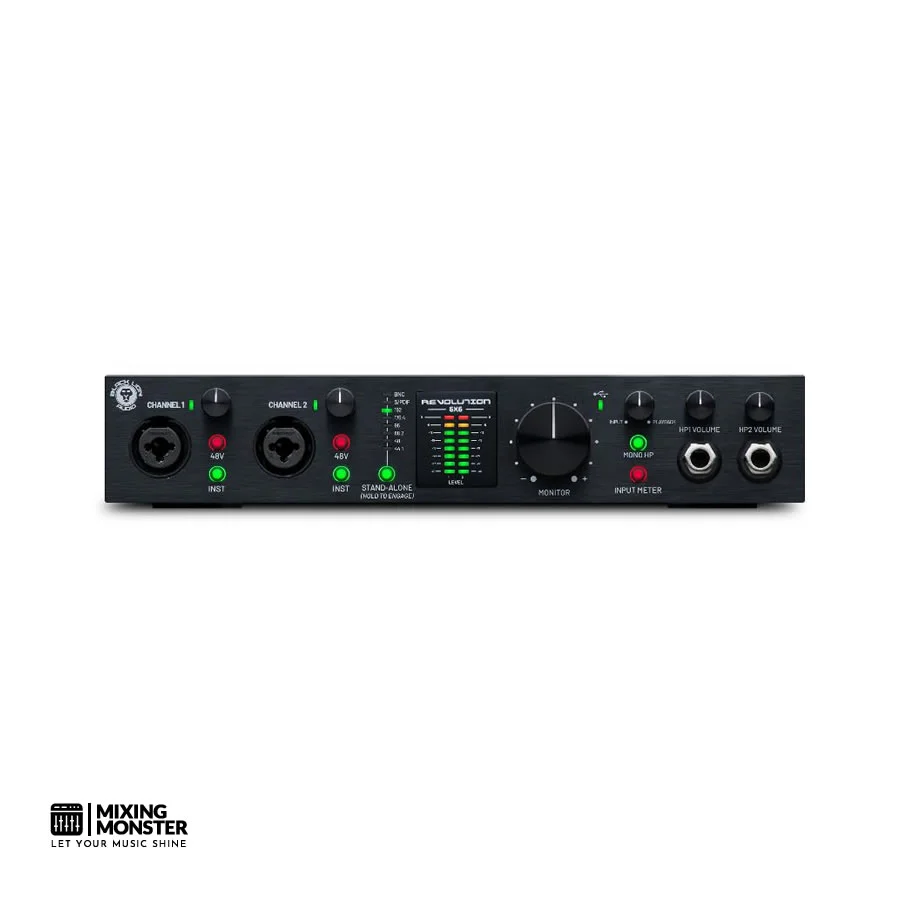
Overview:
The Black Lion Audio Revolution 6×6 seamlessly blends boutique high-fidelity recording with convenient features for a superior studio experience.
Pros:
- Unprecedented audio clarity with top-notch internal components
- Versatile connectivity options, including USB OTG for mobile production
- It comes with a suite of professional software, enhancing its value
Cons:
- It may be overkill for beginners or hobbyists
- The higher price point reflects its professional-level features
- Only two preamps, which might be limiting for larger recording sessions
Unique Selling Point:
The Black Lion Audio Revolution 6×6 distinguishes itself with built-in modifications, usually reserved for high-end, custom audio gear, ensuring superior sound straight out of the box.
Key Benefits:
- Macro-MMC clocking technology ensures precise audio capture and playback, which is critical for professional work.
- Fully decoupled and balanced I/O provides pristine audio signal flow, preventing noise from external sources.
- Included premium software extends the interface’s capabilities for a comprehensive recording setup.
Pricing:
| Average Price | ~ $670 |
Review:
We recently had the chance to work with the Black Lion Audio Revolution 6×6, and it’s clear that this interface targets discerning studio professionals. The construction is robust, which we expect to maintain well under continuous use.
It boasts high-end capacitors and resistors, contributing to its impressively quiet operation. Recording with it is a breeze due to the straightforward interface and the flexibility to connect with various devices, a boon for mobile and studio producers alike.
The included software suite from PreSonus and others adds significant value, giving users various mixing, mastering, and effects processing tools. However, some aspects, like its two-channel limitation, may make you consider other options if you routinely record several sources simultaneously.
We appreciate the attention to detail with the fully balanced I/O and internal noise reduction—it’s apparent that functionality wasn’t an afterthought. Weighing the pros and cons, the Black Lion Audio Revolution 6×6 is a professional-grade interface that could elevate any studio’s recording quality.
The superb sound justifies the premium you pay and the build quality; it’s an investment that we believe will satisfy the most demanding users.
#13 RME Babyface Pro FS
Best Low-Latency Audio Interface
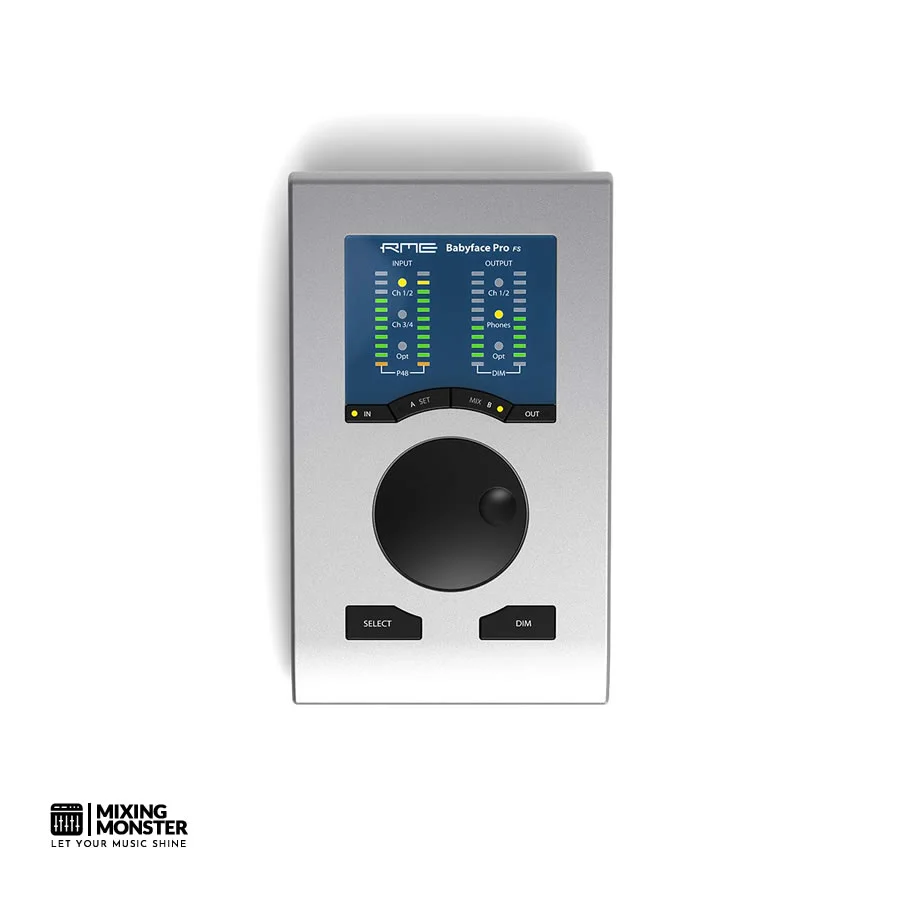
Overview:
Whether you’re recording in the studio or performing live, the RME Babyface Pro FS impresses with low-latency stability and sound quality.
Pros:
- Exceptional low-latency performance
- Robust build quality suitable for travel
- Precision clocking for pristine audio capture
Cons:
- Premium price points may not suit all budgets
- Limited preamps for those needing more simultaneous recordings
- The steeper learning curve for beginners
Unique Selling Point:
The standout feature of the RME Babyface Pro FS is undoubtedly its ultra-low latency. When you’re overdubbing or monitoring live inputs, this interface feels like there’s zero delay, which is critical for professional applications.
Key Benefits:
- The dual microphone/instrument preamps deliver top-tier audio fidelity, making every recording session pleasurable.
- Portability is a huge plus; this unit feels sturdy and confidently travels alongside laptops or tablets.
- The entire SteadyClock FS circuit ensures your recordings are accessible from jitter, offering a sound that is as reliable as it is clear.
Pricing:
| Average Price | ~ $820 |
Review:
The Babyface Pro FS has been an absolute workhorse in our studio testing. From the first use, the clarity and detail it brings to recordings are evident, living up to RME’s reputation for professional-grade audio gear.
It’s also been a breeze on the road; the solid aluminum housing can take a knock or two without missing a beat. While two preamps are plenty for a solo artist or small ensemble, larger groups might need additional preamps or a different model.
That said, it’s been enough for our purposes, and the ease of use once you’re accustomed to the interface is top-notch.
The price is steep, but the Babyface Pro FS has proven that it’s a sound investment, especially for those who value low latency and clean sound. As for drivers, the stability is outstanding. We haven’t experienced any dropouts or compatibility issues, which is essential for maintaining workflow. Some interfaces leave you wrestling with software, but not this one; once it’s set up, it just works, and that’s invaluable.
In conclusion, whether tracking a guitar riff or capturing the nuances of vocal performance, the Babyface Pro FS has performed flawlessly, repeatedly justifying its place in our studio setup. If professional sound quality and build are what you seek, this interface should be on your shortlist.
#14 Arturia Audiofuse Studio
Best For Professional Recording Artists
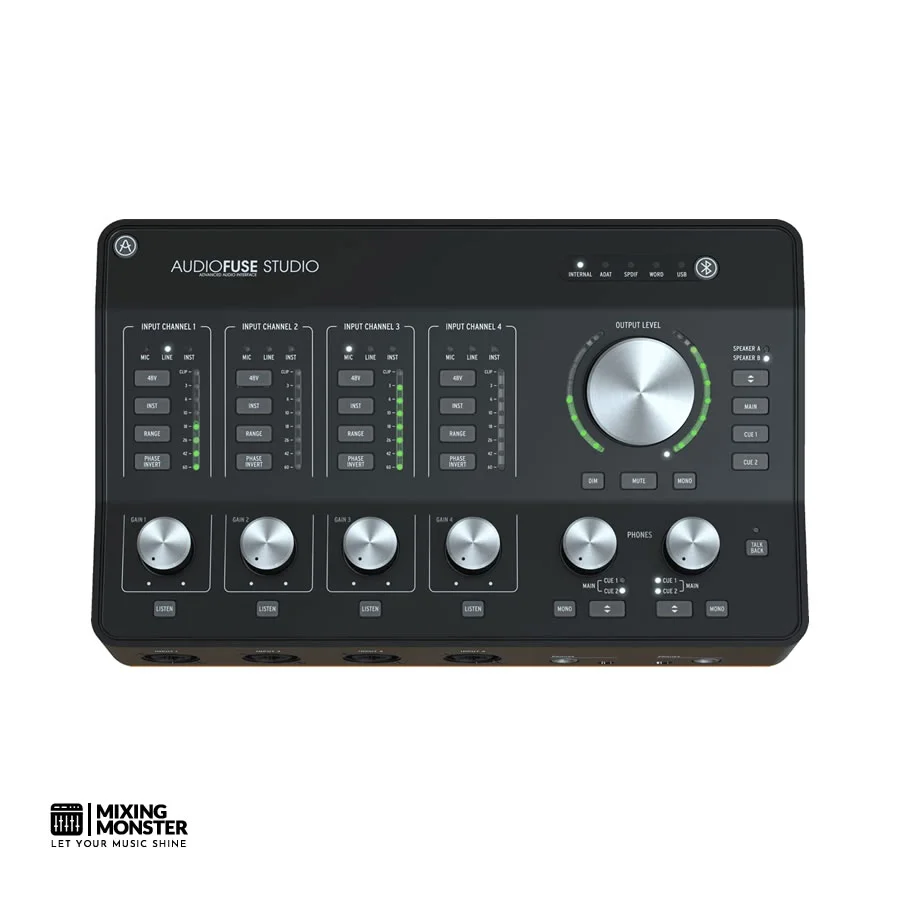
Overview:
Purchasing the Arturia Audiofuse Studio brings high-quality sound and remarkable versatility to your audio production setup.
Pros:
- Superior audio fidelity with premium preamps
- Broad connectivity, including Bluetooth and USB-C
- It comes with a comprehensive bundle of creative software
Cons:
- Learning curve due to advanced features
- Higher price point compared to basic models
- Potentially overwhelming for beginners
Unique Selling Point:
The Arturia Audiofuse Studio stands out with its top-tier preamps and comprehensive I/O options, catering to nearly every recording scenario a musician or producer might encounter.
Key Benefits:
- Four DiscretePRO preamps deliver a crystal-clear sound for capturing high-quality audio.
- Varied connectivity allows seamless integration with diverse studio setups.
- Including a Bluetooth receiver expands playback options and streamlines the creative process.
Pricing:
| Average Price | ~ $860 |
Review:
Having worked with the Arturia Audiofuse Studio, we’ve found this interface to exceed expectations in most respects. The sound quality shines, thanks to the highly acclaimed preamps; your recordings come out crisp and clear, bringing a professional sheen to your projects. It’s a robust piece of kit that feels ready to withstand the daily grind of studio life.
Connectivity is another strong point for this interface. With USB-C and Bluetooth at your fingertips, we’ve integrated it flawlessly within our setup, and its versatility is exceptional. The included creative software bundle has been a pleasant boon, providing tools for immediate music production without additional investment.
However, the wealth of features can be overwhelming for newcomers to music production. There’s a learning curve to harness everything the Audiofuse Studio provides effectively. Its price also places it in a higher bracket, which might be a stretch for those on a tight budget or just looking for a simple plug-and-play solution.
In closing, if you’re a discerning musician or producer keen on impeccable audio quality and expansive connectivity, the Arturia Audiofuse Studio is a formidable choice. This interface fosters creativity and maintains consistently high performance, solidifying its position as a mainstay in our audio recording arsenal.
#15 Universal Audio Twin X DUO USB HE
Best For Professional Home Studios
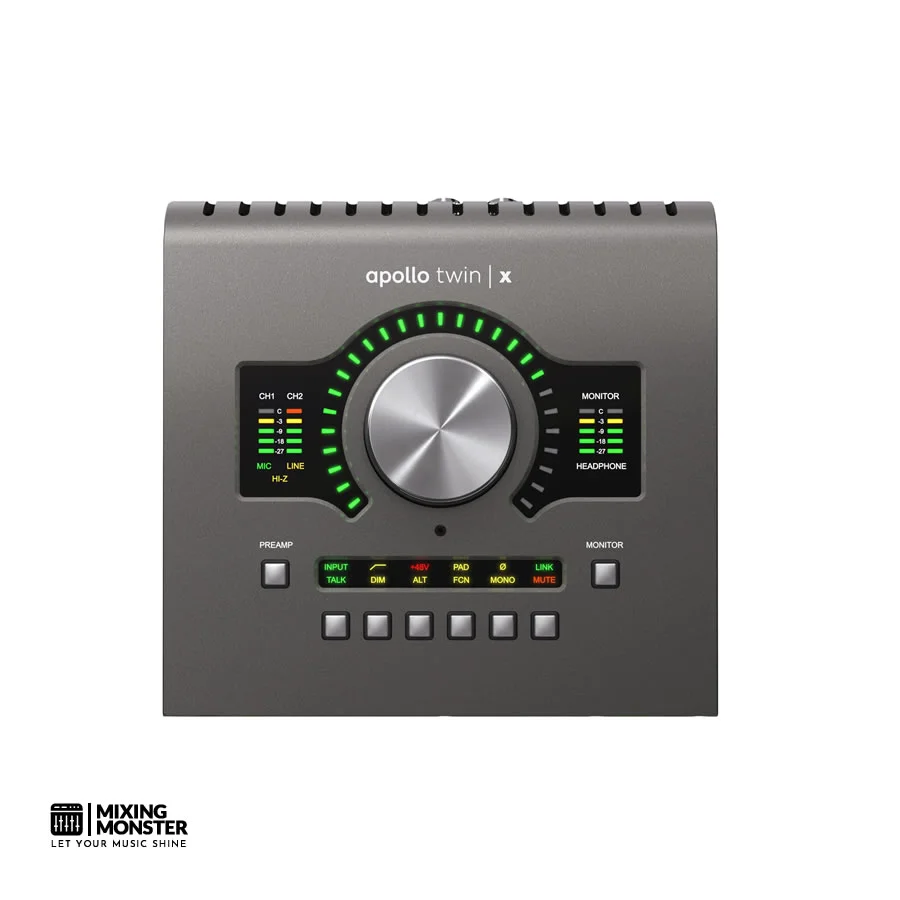
Overview:
For serious recording enthusiasts, the Universal Audio Apollo Twin X Duo USB Heritage Edition is a game-changer with its unparalleled audio conversion quality.
Pros:
- Superior A/D and D/A conversion for pristine sound
- Realtime tracking with UAD-2 DUO Core Processing
- Unison technology for authentic preamp emulations
Cons:
- Higher price points may be prohibitive for some
- Limited to Windows, excluding Mac users
- Requires USB 3.0 port for optimal performance
Unique Selling Point:
The UA Twin X Duo USB Heritage Edition stands out for its Unison technology. It offers us near-flawless emulations of classic preamps and amplifiers, providing an authentic analog recording experience in a digital environment.
Key Benefits:
- Elite-class audio conversion delivers a rich, organic sound, enhancing the recording quality of vocals and instruments.
- The UAD plugin suite offers a variety of professional audio processing tools, ensuring polished, studio-grade tracks.
- Near-zero latency recording enables us to capture performances with remarkable clarity and precision, providing an intuitive recording experience.
Pricing:
| Average Price | ~ $1000 |
Review:
Our first interaction with the UA Twin X Duo USB HE left a lasting impression of robustness and clarity in sound. Recording through this interface feels like blending analog warmth and digital precision – a rare feat.
The unit’s construction is solid, exuding a sense of durability and quality that’s expected from the Universal Audio brand. Working with the included Heritage Edition plugins, we could craft professional-sounding mixes.
Granted, the refined sound comes at a premium, but the investment seems justified for the serious home studio or semi-professional setting.
The only hiccup might be needing a USB 3 port, but with current Windows systems, this should be of little concern. After wrapping up a session with the UA Twin X Duo USB HE, there’s an undeniable sense of satisfaction – the interface delivers on its promise of top-tier sound.
The realization that it’s calibrated for Windows may be a downside for some, but this interface is an impeccable choice for those within its ecosystem.

2. What Is An Audio Interface?
An audio interface is critical for producing high-quality audio on a computer. Think of it as the bridge between our analog sound sources—like microphones and instruments—and the digital realm of our recording software.
Interfaces convert analog audio signals into digital data that computers can process, and they do the reverse when playing back audio from digital to analog.
Key Features:
- Inputs/Outputs (I/O):
These allow us to connect microphones, instruments, and speakers. We’ll typically see interfaces with varying numbers of I/O options. - Preamps:
Integral to quality sound, preamps amplify the weaker signals from microphones. - Data Transmission:
Interfaces send and receive audio to and from our computers through USB, Thunderbolt, or other connection types.
Supported Resolutions And Sample Rates:
- Audio Quality:
Interfaces offer varying qualities of audio resolution—measured in bit depth—and sample rates. Higher numbers usually translate to better sound.
Form Factor:
- There are desktop interfaces, which are compact and sit neatly on our workstation, and rack-mounted units, which are larger and often found in professional studios.
Use For Different Users:
- Home Studios:
A simple, affordable interface with a few inputs may suffice. - Professional Studios often require interfaces with more I/O flexibility, advanced features, and higher audio quality.
Each audio interface serves its specific purpose depending on our needs and the demands of our projects. Selecting the right one is a decision we make based on these needs, ensuring that our recordings are captured with clarity and precision.
3. Audio Interface Buying Guide
When we look for the best audio interface, we first consider the primary use case. Whether for a professional studio setting or a home recording setup, the choice of an audio interface should be driven by its compatibility with our needs.
Key Features to Consider
- Connectivity:
Evaluate the types and number of inputs and outputs. Interfaces have various connection options, such as USB, Thunderbolt, or FireWire. - Audio Quality:
Consider the bit depth and sample rate; higher values can produce better sound quality. - Compatibility:
Ensure the interface works with our computer system and Digital Audio Workstation (DAW). - Latency:
Opt for interfaces with low latency to prevent delay during recording and playback.
Inputs & Outputs
| Type | Purpose |
|---|---|
| Mic Inputs | For connecting microphones |
| Line Inputs | To plug in instruments or other line-level sources |
| MIDI I/O | To connect MIDI devices like keyboards and controllers |
Add-Ons & Budgeting
We must balance costs against the features we require. More expensive interfaces may provide better quality, but we must consider if we will utilize those advanced features.
Durability & Portability
- Durability:
Build quality can affect longevity, especially if we plan to transport the interface. - Portability:
Compact, lightweight interfaces benefit those who work in multiple locations.
Remember, we must assess the audio interface based on our specific requirements and ensure it aligns well with our planned use.
4. Finding Your Perfect Audio Interface: Key Takeaways
When selecting an audio interface, we must consider several crucial aspects to ensure we meet our specific needs:
- Inputs/Outputs:
Assess our needs for the number of inputs and outputs, factoring in the types of instruments we plan to record. - Connectivity:
Ensure our computer has the appropriate connections, USB, Thunderbolt, or otherwise.
Sample Rate And Bit Depth
| Sample Rate | Bit Depth | Use Case |
|---|---|---|
| 44.1 kHz | 16-bit | CD quality, basic home recording |
| 48 kHz | 24-bit | Standard professional recording |
| 96 kHz | 24-bit | High-fidelity recordings |
- Latency:
Look for interfaces with low latency to avoid delays during recording and playback. - Preamps:
The quality of built-in preamps can significantly influence the clarity of our recordings. - Software Compatibility:
Verify the interface is compatible with our chosen Digital Audio Workstation (DAW).
Considering these factors, we position ourselves well to choose an audio interface that aligns perfectly with our recording needs and workflows.
Our Top Picks For The Best Audio Interfaces
Best Budget Audio Interfaces
- Mackie Onyx Artist 1.2
- Presonus AudioBox USB 96
- Audient iD4 MKII
- Universal Audio Volt 2
- Focusrite Scarlett 2i2 4th Gen
Best Midrange Audio Interfaces
- IK Multimedia AXE I/O Solo
- MOTU M4
- Solid State Logic SSL 2+
- Focusrite Scarlett 4i4 4th Gen
- Universal Audio Volt 476P
Best High-End Audio Interfaces
- Focusrite Clarett+ 4Pre
- Black Lion Audio Revolution 6×6
- RME Babyface Pro FS
- Arturia Audiofuse Studio
- Universal Audio Twin X DUO USB HE

5. FAQ
1) What are the top features when choosing an audio interface for music production?
The top features include audio fidelity, number of input/output channels, connectivity options, preamp quality, and digital conversion rates. The interface’s compatibility with your recording software and the overall build quality are also crucial.
2) How do professional-grade audio interfaces differ from budget options?
Professional grade interfaces typically offer superior sound quality with lower noise levels, more durable construction, higher sample rates, and advanced features like expanded connectivity. Budget options may sacrifice some of these aspects to keep costs down.
3) What factors determine the best audio interface for vocal recording?
For vocal recording, preamp quality is paramount as it affects the clarity and warmth of the recording. A high dynamic range and the ability to connect professional microphones through XLR inputs are also essential factors.
4) Which brands are leading the market in audio interface technology?
Leading brands include Universal Audio, Focusrite, Apogee, Behringer, and PreSonus. These brands are well-regarded for their reliability, quality components, and innovative features catering to audio professionals.
5) Why might someone choose a high-end audio interface over a more affordable one?
Professionals may opt for a high-end interface for its exceptional audio quality, expanded I/O capacity, enhanced durability, and long-term reliability. These features are vital for high-stakes recording sessions and professional studio environments.
6) What are the most recommended audio interfaces for beginner producers?
For beginners, interfaces like the Focusrite Scarlett series, PreSonus AudioBox, and Behringer UM2 offer user-friendly operation, solid build, and good sound quality at an affordable price. These are highly recommended for those starting in music production.

